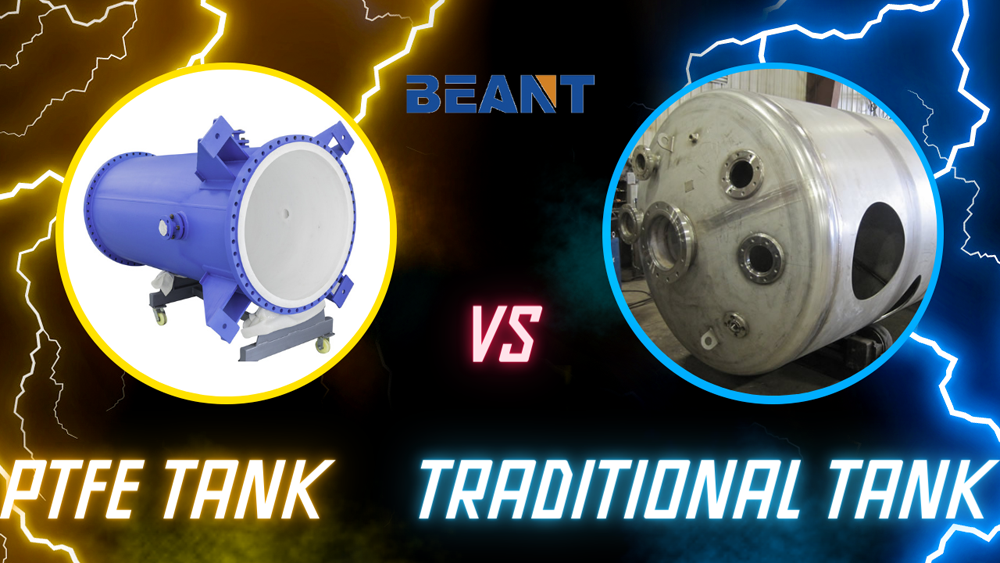
PTFE (Polytetrafluoroethylene) tanks and traditional tanks, such as those made from steel or plastic, serve as essential storage solutions in various industrial applications.
PTFE Tanks: Known for their exceptional chemical resistance and non-reactive properties, PTFE tanks are widely used in industries dealing with corrosive substances. They provide a reliable solution for storing aggressive chemicals and high-purity substances.
Traditional Tanks: These tanks are typically made from materials like steel, polyethylene, or fiberglass. While they offer durability and versatility, they may not match the chemical resistance and non-reactive nature of PTFE.
Importance of Storage Solutions:Industrial applications rely heavily on efficient and safe storage solutions to ensure the integrity of stored materials and the safety of operations. The choice between PTFE and traditional tanks depends on factors such as the nature of the stored substance, environmental conditions, and cost considerations.
When comparing PTFE tanks to traditional tanks, it is essential to understand the material composition and inherent properties that influence their performance and suitability for various applications.
Material Composition: PTFE, commonly known as Teflon, is a synthetic fluoropolymer with exceptional non-reactive and chemical-resistant properties.
Properties:
Chemical Resistance: PTFE tanks exhibit outstanding resistance to a wide range of chemicals, making them ideal for storing corrosive substances.
Non-reactivity: PTFE does not react with most substances, ensuring the purity and stability of the stored materials.
Temperature Tolerance: These tanks can withstand extreme temperatures, both high and low, without degrading or losing structural integrity.
| Material | Composition | Properties |
| Steel | Carbon steel or stainless steel | Durable, high strength, but susceptible to corrosion over time. |
| Plastic | Polyethylene (PE), Polypropylene (PP) | Lightweight, corrosion-resistant, but limited temperature range. |
| Fiberglass | Reinforced fiberglass | Strong, corrosion-resistant, but can be brittle. |
PTFE Tanks:
Advantages: Superior chemical resistance, non-reactivity, and broad temperature tolerance.
Disadvantages: Higher initial cost compared to some traditional materials, potential issues with mechanical strength under certain conditions.
Traditional Tanks:
Advantages: Generally more affordable, a variety of materials available for different needs, robust mechanical properties.
Disadvantages: Susceptible to corrosion (especially steel), limited chemical resistance (plastics), and potential brittleness (fiberglass).
This comparison highlights the unique benefits of PTFE tanks, especially in environments where chemical resistance and non-reactivity are critical. Traditional tanks, while versatile, may not always meet the stringent requirements needed for certain industrial applications.
When evaluating the performance and durability of PTFE tanks versus traditional tanks, several key factors come into play.
Chemical Resistance: PTFE's superior chemical resistance allows these tanks to store a wide range of aggressive chemicals without degradation.
Temperature Stability: PTFE tanks can operate in extreme temperatures, maintaining structural integrity and performance.
Longevity: Due to their resistance to chemicals and environmental factors, PTFE tanks often have a longer lifespan with lower maintenance needs.
Steel Tanks:
Durability: High mechanical strength, suitable for high-pressure applications.
Corrosion: Requires coatings or linings to prevent rust and corrosion.
Plastic Tanks:
Flexibility: Good for a variety of chemicals but with limitations on temperature range and chemical compatibility.
Durability: Less durable than steel, prone to damage under extreme conditions.
Fiberglass Tanks:
Strength: Good mechanical properties, suitable for corrosive environments.
Brittleness: Can become brittle over time or under impact, leading to potential failures.
In summary, PTFE tanks offer superior performance in terms of chemical resistance and temperature stability, making them ideal for harsh environments. Traditional tanks provide a balance of cost and performance but may require additional measures to enhance their durability and resistance.
Safety and environmental impact are crucial considerations when choosing between PTFE and traditional tanks.
PTFE Tanks:
Non-reactivity: Reduces the risk of hazardous reactions, ensuring safer storage of volatile substances.
Integrity: Minimal risk of contamination or leaks, enhancing overall safety.
Traditional Tanks:
Steel Tanks: Require regular maintenance to prevent corrosion-related failures.
Plastic Tanks: Risk of chemical reactions with certain substances, leading to potential leaks.
Fiberglass Tanks: Can fracture under impact, posing a risk of spillage.
PTFE Tanks:
Longevity: Longer lifespan reduces the need for frequent replacements, minimizing waste.
Recycling: PTFE is challenging to recycle, posing environmental concerns.
Traditional Tanks:
Steel Tanks: Recyclable but can contribute to environmental pollution if not properly managed.
Plastic Tanks: Potential environmental hazard if not disposed of correctly, though some types are recyclable.
Fiberglass Tanks: Limited recycling options, leading to disposal issues.
Choosing the appropriate tank type involves balancing safety, environmental impact, and operational needs. PTFE tanks excel in safety and chemical handling, while traditional tanks may offer more straightforward disposal and recycling options, albeit with potential compromises in safety and environmental protection.
The cost analysis of PTFE tanks versus traditional tanks involves evaluating both the initial investment and the long-term operational costs associated with each option.
PTFE Tanks:
High Initial Cost: PTFE tanks typically have a higher initial purchase price due to the cost of materials and specialized manufacturing processes.
Traditional Tanks:
Variable Cost: The initial cost can vary widely depending on the material. Steel tanks are generally more expensive than plastic tanks, but less costly than PTFE tanks. Fiberglass tanks fall in between.
Maintenance:
PTFE Tanks:
Low Maintenance: Require minimal maintenance due to high chemical resistance and durability.
Traditional Tanks:
Higher Maintenance: Steel tanks need regular inspections and protective coatings to prevent corrosion. Plastic and fiberglass tanks may require periodic checks for structural integrity.
Operational Costs:
PTFE Tanks:
Efficiency: Longer lifespan and reduced maintenance lower operational costs over time.
Traditional Tanks:
Varied Costs: Depending on the material, operational costs can include frequent repairs, replacements, and additional safety measures.
| Cost Factor | PTFE Tanks | Traditional Tanks |
| Initial Cost | High | Variable (depends on material) |
| Maintenance | Low | High (especially for steel) |
| Operational Costs | Low (due to durability) | Variable (more frequent replacements/repairs) |
Overall, while PTFE tanks have a higher upfront cost, their lower maintenance and operational costs can make them more cost-effective in the long run, especially for applications involving aggressive chemicals and extreme conditions.
PTFE tanks and traditional tanks serve different industries and applications based on their unique properties and advantages.
Chemical Industry: Widely used for storing corrosive chemicals due to their superior chemical resistance.
Pharmaceuticals: Ideal for high-purity substances, ensuring no contamination.
Food and Beverage: Used where non-reactivity with stored substances is critical.
Biotechnology: Suitable for storing sensitive biological materials.
Water Treatment: Steel and plastic tanks are commonly used due to their cost-effectiveness and adequate chemical resistance for water treatment processes.
Oil and Gas: Steel tanks are favored for their strength and durability in storing petroleum products.
Agriculture: Plastic tanks are popular for their lightweight and ease of handling, used for storing fertilizers and pesticides.
General Storage: Fiberglass tanks are used for a variety of non-aggressive chemicals and substances.
Case Studies:
PTFE Tank Implementation: A pharmaceutical company successfully switched to PTFE tanks to store high-purity solvents, significantly reducing contamination risks and maintenance costs.
Traditional Tank Implementation: An agricultural business uses polyethylene tanks for fertilizer storage, benefiting from the low cost and ease of transport and installation.
This diverse range of applications highlights how the choice between PTFE and traditional tanks is influenced by the specific needs of each industry.
In conclusion, both PTFE tanks and traditional tanks have distinct advantages and limitations that make them suitable for different industrial applications. PTFE tanks offer unparalleled chemical resistance, non-reactivity, and long-term cost efficiency, making them ideal for industries dealing with aggressive and high-purity substances. Traditional tanks, while generally more affordable initially, provide versatility across various applications but may require more frequent maintenance and replacement.
Feel free to leave your message on our board. If you're looking to inquire about prices or place an order, this is the right place! Let us know the details of your needs, and our team will get back to you with a personalized quote as quickly as possible. We're here to ensure your experience is seamless and satisfactory. Share your requirements or ask any questions you might have - we're eager to assist and look forward to doing business with you!
Name:Tim
Phone:+86-15716151880
Email:[email protected]
Company:BEANT
Address:No. 28, Luoshen Road, Luoshe Town, Huishan District, Wuxi City, Jiangsu Province
